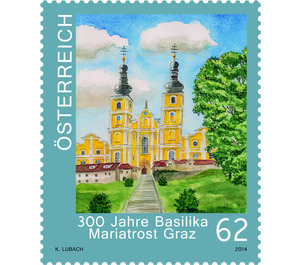300 years - Austria / II. Republic of Austria 2014 - 62 Euro Cent
Theme: Architecture
| Country | Austria / II. Republic of Austria |
| Issue Date | 2014 |
| Face Value | 62.00 |
| Edition Issued | 360,000 |
| Printing Type | offset |
| Stamp Type | Commemorative |
| Item Type | Stamp |
| Chronological Issue Number | 2493 |
| Chronological Chapter | OOS-OE2 |
| SID | 936651 |
| In 72 Wishlists | |
One of Styria's most famous pilgrimage sites is celebrating its 300th anniversary this year, and Austrian Post is honoring this with a special stamp from the series "Churches in Austria". The foundation stone for the Basilica Mariatrost in Graz was laid in 1714, namely on the Purberg in the northeast of the city, where the previous building, the Schlössl, had been recognized as a place of pilgrimage shortly before. A statue of the Virgin, attributed to miracle activity, was placed in the chapel of the castle and became the centerpiece of the church after the church was built. Numerous legends entwine around this representation of the Blessed Mother, including that the daughter of Purburg Castle lords was cured by her from a serious illness. Another founding legend tells of a Viennese butcher who, after an accident at work, carried a cross from Vienna to Mariatrost and returned home cured. It is certain that the miraculous image comes from the pen Rein, it was originally created in the mid-15th century in the Gothic style and later baroque. The entire church was built in late baroque style, the so-called imperial baroque. The construction was led by Andreas and Johann Georg Stengg and by Emperor Karl VI. especially encouraged. Widely visible is the basilica through its two towers and a dome. The church is surrounded by a former Pauline and later Franciscan monastery. Under Joseph II, who gave up monasteries and forbade pilgrimages, had to leave the Pauliner Mariatrost, the monastery tracts were then even used temporarily as stables. In 1846, the Franciscans finally took over the building complex. In 1999, the church was elevated to the basilica minor, today it is headed by the priests of the Diocese of Graz-Seckau. Those who do not travel from far away can at least go on a small pilgrimage path through the Angelus Stairs and climb the more than 200 steps. It should help to establish the connection to God. Once at the top, you can walk through the portal above the "Go into the house of your mother" emblazoned in golden letters. In the interior of the church, the high altar impresses, in the middle of which stands the stately statue of the Virgin, surrounded by mighty marble columns, bearing the inscription "Solatium vitae nostrae" (comfort of our lives) above the radiate wreath. The sermon pulpit, which is decorated with scenes from the life of Mary, is especially grandiose. The side altars are dedicated to the Nativity of Mary and St. Joachim. The frescoes also depict scenes from the life of the Blessed Virgin Mary as well as from the time of the Turkish wars. They come from Lukas von Schramm and Johann Baptist Scheidt, who had to commit to working in the style of Schramm. In memory of the Marian apparitions in the French pilgrimage town of Lourdes, a separate Lourdes grotto was built in Mariatrost in the form of an artificially reproduced cave.


